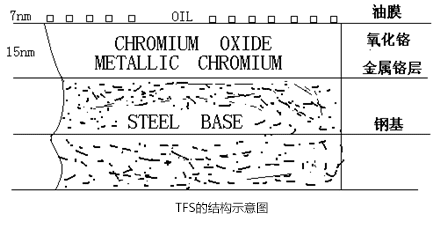Tin Free Steel£¨TFS£©
- Production Process
- Product Features
- Surface Inspection Items
- TFS Structure
- Features of TFS Products
- Differences between ETP and TFS
- Specifications and Parameters
TFS Structure
Generally, it is believed that the tin free steel (TFS) is
composed of four layers, including steel base, metallic
chromium layer, chromium oxide layer and oil film, as shown
below.

Function of Each Layer of TFS:
①The role of steel base is similar to that of ETP, which ensures the formability of TFS usage and machining and provides strength of finished products;
②Metallic chromium layer has strong passivation capability and good corrosion resistance, but as it is cathodic coating, it can only provide mechanical protection for steel base. Besides, due to strong passivation capability of metallic chromium, an extremely thin layer of passivation film is easy to produce (chromium oxide);
③Chromium oxide layer has relatively high chemical stability, and the electrode potential of the film is more positive than that of iron. When surrounded by ordinary corrosive media, it is cathodic coating, requiring coating to protect the contents. As an amorphous layer, the layer can close pores of the metallic chromium layer and provide excellent coating adhesion;
④The role of the oil film is similar to that of ETP, and its lubrication is better than that of ETP, for tin itself is of lubricity.
Features of TFS Products
①Excellent paint adhesion: TFS has excellent paint adhesion properties that far surpass those of ETP, and the corrosion resistance of coated TFS is almost the same as that of ETP;
②Excellent heat resistance: High-temperature baking of TFS causes neither discoloration nor deterioration in material properties.
③Excellent resistance to sulphur blackening: The metallic chromium in TFS has excellent sulphide resistance when canning protein-rich foodstuff, whereas ETP requires expensive sulphur resistant lacquer;
④Excellent filiform rust resistance: TFS has excellent under film corrosion resistance, which is superior to that of ETP;
⑤Excellent alkali resistance: The chromium coating in TFS is not amphoteric, making TFS a preferred choice for packing alkaline products such as detergents and pigment dispersants.
Differences between ETP and TFS
①Appearance: Even when the same surface finish as ETP is applied to the substrate steel sheet, TFS provides the unique surface luster characteristic of metallic chromium as the chromium coating is extremely thin and transparent (for example, chromium coating of 70mg/m2 ¡Ö0.01¦Ìm). However, any defect on the TFS surface is also visible to the naked eye;
②Corrosion resistance: After painting, TFS has excellent corrosion resistance which is even superior to that of ETP. Besides, production costs can be lowered through economization of expensive metallic tin. Therefore, TPS is generally used with both surfaces painted;
| Black Plate | Nominal Thickness /mm | Nominal Width /mm | Nominal Length (Sheet) /mm |
|---|---|---|---|
| Single Reduce | 0.17¡«0.55 | 700¡«1200 | 500¡«1168 |
| Double Reduce | 0.12¡«0.36 |
③TFS is not compatible with soldering. Therefore, it cannot be used for applications requiring tin soldering, such as for production of some electronic devices;
④Weldability: Although TFS can be welded when the metallic coating layers are removed, its weldability is inferior to ETP. Currently, electric resistance welding is widely used for three-piece cans; thus, TFS cannot be used for manufacturing three-piece cans. It is widely used in replacement of ETP in market segments not requiring welding, such as metal closures and ends, DRD cans and cemented seam cans.
⑤Coating weight: TFS generally has only one single coating weight, while ETP has a multiplicity of coating weights which are able to meet different requirements of different applications.
Specifications and Parameters
| Metallic Chromium Layer (mg/m2) (one side) | Chromium Oxide Layer (mg/m2) (one side) | ||
|---|---|---|---|
|
Minimum Average
Coating Weight |
Maximum Average
Coating Weight |
Minimum Average
Coating Weight |
Maximum Average
Coating Weight |
| 50 | 150 | 5 | 35 |
| Categorization | Category | Code (s) | |
|---|---|---|---|
| Black Plate | £ | MR, L | |
| Temper Grade | Single Reduce | T-1.5, T-2, T-2.5, T-3, T-3.5, T-4, T-5 | |
| Double Reduce | DR-7M, DR-8, DR-8M, DR-9, DR-9M, DR-10 | ||
| Annealing | Continuous Annealing | CA | |
| Box Annealing | BA | ||
| Surface Finish | Single Reduce | Bright surface | B |
| Stone surface | R | ||
| Stone rough surface | R2 | ||
| Matte surface | M | ||
| Double Reduce | Stone surface | R | |
| Matte surface | M | ||
| Electrochemical passivation | CE | ||
| Edge Shape | Straight line | SL | |
| Temper Grade Code | Hardness (HR30Tm) | |
|---|---|---|
| Target | Permissible Range | |
| T-1.5 | 51 | 51±3 |
| T-2 | 53 | 53±3 |
| T-2.5 | 55 | 55±3 |
| T-3 | 57 | 57±3 |
| T-3.5 | 59 | 59±3 |
| T-4 | 61 | 61±3 |
| T-5 | 65 | 65±3 |
| DR-7M | 71 | 71±5 |
| DR-8/DR-8M | 73 | 73±5 |
| DR-9 | 76 | 76±5 |
| DR-9M | 77 | 77±5 |
| DR-10 | 80 | 80±5 |
| Hardness (a) is the average hardness of two test specimens, and one of the test values is allowed to exceed the specified permissible range by one unit. | ||
